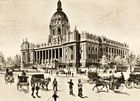Home of the Parliament of Victoria since 1856, the grandiose building is located on a 4.43 hectare site at the intersection of Spring and Bourke streets. Designed by Peter Kerr, Parliament House was constructed in stages. The building is, however, incomplete. Plans to construct a south-east corner, a north wing, and most spectacularly, a centred dome, have not been actualised. Although Premier Kennett in the early 1990s reconsidered the construction of the dome, it was once again deferred.
After the installation of the Marshall Woods’ sculptured statue of Queen Victoria in 1883, the great hall was renamed Queen’s Hall. According to custom, Royalty, unless in war time, is supposed to be depicted as leading with the right foot. Queen Victoria, however, is leading with her left. Perhaps this oversight has been the reason for the statue’s misfortune, as over the years it has been subject to breakage twice and in December of 1913 Ernest Roberts MHR collapsed alongside the statue, hitting his head on the base and subsequently died.
On the 28th of August in 1860 an irate group of red ribbon wearing protestors attempted to storm the Parliament behind the slogan “A Vote, a Rifle and a Farm”. The key reason for protest was that the decline of alluvial gold mining had spurred demands for farming land, which was subsequently locked up by squatters. At 10.30 that night the Riot Act was read by the mayor under a light held by Captain Standish. Dozens of police were injured and many an arrest was made, and the following morning hundreds of special constables were sworn in. A legacy of these events can still be seen, high on the Western Facade, visible in the stonework on the upper floor, two gun slots were afterwards installed. They were ready, just in case, further rebellion broke out.
Parliament House is emblematic of Melbourne, a powerful piece of architecture situated at the picturesque top end of the city. What did the architect Peter Kerr think about the project? Well, in 1904, he told the Royal Institute of Architects that the land on which the Houses of Parliament were built was once full of dirt and rubbish and “a harbour for undesirable characters”. But surely that’s not the case anymore…


